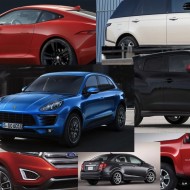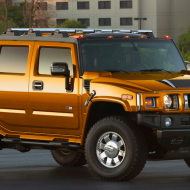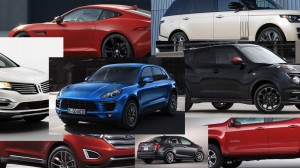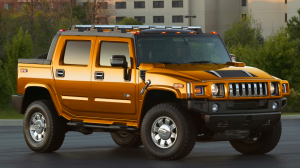Feature: A Look Back At The Los Angeles Auto Show
Posted by Doug DeMuro in Feature on | 10 comments
The Los Angeles Auto Show is over, and I think I speak for everyone in the business when I say that I already miss it. I know I speak for Big Three staffers, who will now fly home to frigid Detroit, return to their frigid desks, and presumably spend the frigid Thanksgiving holiday searching for job openings in Southern California.
Of course, the LA Auto Show isn’t really over. Only the press days have passed, which means the show is now filled with normal residents of Los Angeles, people just like you and me except occasionally they see minor celebrities at the airport.
The auto show world depends on these people: good, hardworking Americans who take time from their busy schedules just to see the latest models; who stand in line for hours to get tickets; who believe an unlocked car is an invitation to steal the radio buttons. Salt of the earth folks, really.
But if you’re not in LA, you may have already forgotten about this year’s show. Fortunately, I’m here with my usual auto show retrospective to remind you of the many highs and lows from Los Angeles. Here goes:
Porsche started things off by revealing a new crossover, the Macan, its latest in a series of models designed to piss off the kind of people who haven’t purchased a new Porsche since the 944, yet still complain about the brand’s direction on Internet forums.
Nissan debuted several eye-grabbing new models in LA, including the sporty Juke NISMO RS (211 hp). The latest Juke slots above the Juke NISMO (197hp) and the regular Juke (188hp), proving that even a frog-shaped compact crossover can learn a lesson or two from the Porsche 911.
Nissan also showed off the seriously cool Sentra NISMO Concept, a high-performance sedan released to collective gasps from assembled automotive journalists who could’ve sworn Nissan stopped making the Sentra six, maybe seven years ago. According to Nissan’s press release, “we also still make the Quest, you know.”
Chevrolet rolled out the Sonic Dusk, a new trim level that features dark wheels primarily aimed at addressing rental car agency complaints about the amount of time spent wiping off brake dust.
Chevrolet also rolled out the all-new Suburban to the excitement of precisely no one in eco-obsessed Los Angeles. There were, however, restrained smiles of delight from tudor-style homes in Connecticut, where wealthy Protestant families might finally replace the 1995 model they’ve been using to haul their boat to the lake for the last two decades. For its part, Nissan responded to the new Suburban by reminding shoppers “Hey everyone, we still build the Armada. It has a V8 and everything.”
Hyundai says it’s going to release a hydrogen-powered SUV, the Tucson Fuel-Cell, sometime next year. We can only imagine the mental anguish this new option will cause all 19 nationwide Honda FCX Clarity drivers as their leases expire.
Lincoln revealed the handsome new MKC crossover, which will undoubtedly turn around the Lincoln brand, and if it doesn’t, then the next one will.
In “you must be dreaming” news, Kia showed off a new sedan called the K900, which will compete in the fast-moving “full-size sedan” segment that currently consists of old people deciding between the Hyundai Azera, the Toyota Avalon, or just keeping their 1998 Buick LeSabre for a few more years. Upon seeing the K900, Nissan PR staff issued a press release insisting that “The Maxima is still for sale. Really, it’s around here somewhere.”
Jaguar showed off an all-new F-Type Coupe, which boasts handsome styling, V6 or V8 power, and a larger rear end where Jaguar can store ever-increasing amounts of trunk money.
Subaru used this year’s LA Auto Show to roll out the gorgeous Legacy Concept, which features a beautiful coupe-like profile and flared fenders. Unfortunately, the Legacy Concept will reportedly stick to Subaru’s typical concept car strategy, meaning its primary purpose is to show attendees precisely what the next Legacy could look like, but won’t.
Ford showed off the all-new Edge Concept, which offers start/stop technology in an apparent bid to piss off any remaining customers who haven’t already been angered by SYNC and MyFord Touch.
The new long-wheelbase Range Rover LWB is a high-end luxury SUV designed to attract wealthy new buyers to the brand. Of course, they will all leave the brand upon discovering that they’ll be spending half their lease driving an LR2 with “LAND ROVER SERVICE LOANER” window decals.
Mercedes really stole the show with this year’s Vision Gran Turismo Concept, a crazy looking futuristic coupe with a teardrop shape and huge wheels. While the Vision GT doesn’t have an engine, Mercedes told journalists to pretend it has a 577-horsepower turbocharged V8. Upon realizing this is a potential strategy, Mitsubishi told journalists to pretend that its cars compete with Ford, Honda, and Toyota.
Oh, and I almost forgot: Chevrolet also rolled out the new Colorado pickup, which will be highly exciting to city-dwelling plumbers in about four years, once used models reach $10k. Reached for comment, Nissan said: “I think we still build the Frontier, but let me check. I know we build the Titan.”
And there it is, ladies and gentlemen: the Los Angeles Auto Show. If you’re thinking of visiting, just remember: it’s never too early to start a collection of radio buttons. Oh, and be sure to check out the Nissan Murano which, I’m told, is still available as a new car.
I Went to the Dragstrip With My CTS-V Wagon… And Some Other Cars
Posted by Doug DeMuro in Feature on | 2 comments
When you have a Cadillac CTS-V Wagon, you want to do things with it. Wash it, for example. Or explain why you bought it to your Audi-driving neighbors, whose only experience with Cadillac came when they took away grandma’s keys and sold her DeVille to CarMax. But you wouldn’t want to drive it. Oh, no. That would require a) seeing out of it, which is impossible; and b) fueling it, which is a real chore, since I am convinced the entire fuel tank consists of one single repurposed 2-liter bottle of Coca-Cola.
However, I recently laughed in the face of these petty challenges when I decided to take my CTS-V Wagon to the Atlanta Dragway in rural Commerce, Georgia, for the weekly “Fast Friday” amateur drag racing event. (Motto: “Beat your friends on Friday; beat your wife on Saturday!”) This, to the best of my recollection, is what happened.
First of all, I should mention right away that we didn’t have just one CTS-V Wagon. In fact, we had two CTS-V Wagons. The other was driven by my friend Dieter, who declined to let me print his full name since he also has an automatic, and he’s afraid of what you might do to him. Interestingly, a third CTS Wagon passed as we pulled out of my driveway to leave for the dragstrip, marking the largest number of CTS Wagons together in one place outside of the “Unsold Inventory” lot at GM Headquarters.
Our group also consisted of a few other interesting cars. I brought my Nissan Cube, largely because I feel that vehicle’s drag racing potential is too often ignored by most traditional automotive news outlets. We also had a 2005 Toyota Corolla, a stick shift Infiniti G37S, and a Lexus CT 200h, which is a handsome little hatchback that sort of looks like a Mazda3, except with the fuel economy of a Prius and the acceleration of tree growth. In other words: we were those assholes who slowed down the guys with built Camaros that run sevens.
Except, fortunately, there wasn’t really anyone to slow down. We did this only a few weeks ago, which meant it was pretty cold. (“Good for performance,” said a guy who was running a Nissan Titan that appeared to be completely stock, except for a six-inch lift.) As a result, the stands were empty, the crowd was thin, and the announcer – who told me last year that I was “late for soccer practice” when I showed up with my E63 AMG wagon – was nowhere to be found.
This meant we had the strip primarily to ourselves. We took full advantage of this fact by racing, over and over, in every automotive combination you can possibly think of. Cube versus Corolla? Done. V Wagon versus V Wagon? Of course. G37S versus lifted 1970s Chevy pickup flying the rebel flag? Obviously. CT 200h versus newly-planted sapling in the parking lot? Do you even have to ask?
We did this for hours and hours. I only drove three or four times, but the whole experience gave me some insight into the drag racing community; insight that I will now share with you, a typical car enthusiast who has not yet visited the dragstrip because when your wife hears “drag racing,” she thinks about Chip Foose driving one of those Top Fuel cars that shoots fire. And that insight is: bring an automatic.
That’s right! You guys have made fun of me for weeks, months even, for getting an automatic V Wagon. But it turns out that automatic is actually better for the dragstrip. While a stick shift guy has to sit there and think about the clutch, and the gear lever, and the RPMs, and the launch, all I have to do is throw my car in “Sport,” push the pedal, and collect my time slip at the end. An idiot could do this, a fact of which I’m certain, because I personally did it several times.
So automatic is definitely the way to go. Never mind that 99.9994 percent of my driving isn’t on the dragstrip: I now feel vindicated.
Speaking of automatics, I know you’re all wondering what it’s like to drag race a Nissan Cube, so here’s a general overview. First, you line up at the lights with an almost incredible sense of self-consciousness; the same sense you might get if you were a black teenager and you just walked in to Barney’s. This stems from the fact that you know every single person in the stands is wondering why the hell some dern cityfolk brawt out one of dem Korean box cars. Also, you know they have guns.
Next, you summon your inner-NHRA competitor. You press the gas and brake at the same time; you intently watch the lights; they turn GREEN!; you release the brake; your tires chirp… and you roll away at the same velocity as a funeral procession. The whole thing actually ends up being very pleasant, and you really get to know the dragstrip, since you see it go by so slowly. Also, you are constantly worried the Cube might simply explode, since the tires are flat-spotted and the oil hasn’t been changed since 2011.
But you’re probably more interested in the Cadillac. Before we get into this, I want to mention that Dieter has an aftermarket air intake on his car. I hold this and solely this responsible for the fact that he beat my best time by more than half a second. It can’t possibly be that he’s a better driver than me, since I’m an excellent driver, and I know this because I only crashed two of my five Porsche company cars. (That’s less than half.)
Anyway: in the end, Dieter’s best time was just a hair over 12 seconds – 12.06, if I remember correctly. My car was good for 12.6 seconds with me in the driver’s seat, though my friend Mark managed to get it down to 12.5. The times, though, weren’t as important as the sheer enjoyment of lining up at the lights, pushing the pedal down, hearing the V’s supercharger whine and its V8 roar to life, listening to it go through the gears, and then, at the very end, looking in the mirror and reminding myself that I’m sitting in a station wagon.
The Cube’s best run, meanwhile, was just a hair over 17 seconds. We repeatedly tried to break into the 16s, but eventually the self-consciousness got to us and we gave up. Maybe next time we’ll come back with rebel flags. Rebel flags… and an oil change.
This article originally appeared on Jalopnik.
Feature: The Ridiculous Myth of the Executive Demo
Posted by Doug DeMuro in Feature on | 15 comments
Well, ladies and gentlemen (Ladies! Hah!), the time has come: I’ve decided to debunk another myth. You may remember the last time I debunked a myth. It was when I asserted that the Tail of the Dragon isn’t everything it’s cracked up to be, which led to an angry, drawn-out fight between serious drivers and the kind of people who think of a pickup bed as transportation to church.
Fortunately, today’s myth is less controversial and far more informational. That’s because it involves serious automotive insider knowledge that comes from me, a serious automotive insider who once passed an entire 40-hour work week playing web-based Flash games. And what’s the myth? Well, it has to do with the executive demo.
Before we get started, I think it’s important to explain exactly what an “executive demo” is. Here’s what happens: you go to your dealership and find a car on the lot that isn’t quite new, but has, maybe, 5,000 miles on the odometer. You ask the salesman why there’s a car that’s so new, with so few miles, on the used car lot. And he says: “Please don’t disturb me while I’m playing Flash games.”
No, what he says is that this car is an “executive demo.” In other words, it’s a car that was used as a company vehicle by someone at the corporate office; someone so high up that he had a free car; someone so high up that he got free gas; someone so high up that he would never dream of, say, using his company car to teach people to drive a stick shift, which is something that I certainly never did in my company cars, if anyone from my former employer is reading this.
This is exactly what happened when I bought my Cadillac. The first owner listed on the Carfax was a “corporate fleet” with a “corporate title,” which meant it was originally owned by GM. This, by the way, is the only way they could sell new CTS-V wagons: to GM employees who received a sizable discount.
When I asked the salesman about this, his response was simple: this car was an “executive demo,” driven by the kind of General Motors executive who is incredibly careful; an executive who would never do a smoky burnout; an executive who was probably a little old lady hired specifically to drive to and from church, just to be sure the car can operate under such peaceful conditions. Little did he know that he was talking to someone with considerable experience tying a mattress to the top of a Porsche Cayenne, not that I ever did that in any of my company cars, if anyone from my former employer is reading this.
I was reminded of all this executive demo stuff the other day as I browsed YouTube. There, I came across a video where Matt Farah spends what looks like the better part of a weekend doing burnouts in a Shelby GT500. For those who can’t watch the video, I’ll sum it up like this:
Matt Farah driving and reviewing the GT500: 80 percent
Matt Farah enveloped in an enormous cloud of tire smoke: 20 percent
I mention this because, in the video, Matt Farah is almost certainly driving a press car – which is owned by a “corporate fleet” with a “corporate title,” if you ask Carfax. In other words: at this very moment, that car is probably sitting on the lot of Anytown Ford, where the sales staff is telling people that Bill Ford himself drove the car, but only in the occasional parade, where he would throw Gobstoppers to underprivileged Detroit-area schoolchildren while trying to keep the needle below five miles per hour.
All of this makes me think about the space shuttle. You may be familiar with the space shuttle, as it earned quite a lot of fame during its career as a shuttle … for space. Occasionally, it was also transported on the back of another, larger aircraft, like a mama bear giving a piggyback ride to her cub after her cub had just finished a journey … to space. But the space shuttle was also the cause of the most notorious executive demo in history.
As I recall, this is what happened: a space shuttle was recently towed through the Los Angeles area for some reason, possibly as a prop for the next Armageddon movie, where Bruce Willis comes back from the dead to strangle anyone caught humming “I Don’t Wanna Miss a Thing” by Aerosmith. Specialized trucks did most of the towing, except for one short stretch when the shuttle crossed over the 405 Freeway. That part was done by a 2012 Toyota Tundra.
That’s right: a 300,000-pound, 184-foot interstellar flying machine was towed by a Toyota Tundra. And not just any Tundra: one that’s owned by a “corporate fleet” with a “corporate title.” Now that’s something I actually never did in my company car.
I can only guess where this Tundra is now, but I bet the owner occasionally says to his passengers: “Is it just me, or did you feel the transmission slip?”
Nah, probably not. I’m sure that Tundra doesn’t have any problems. I’m sure that Tundra is in excellent shape. After all, it was only driven carefully, to and from work, in warm weather, by some bean-counting vice president. Just like all executive demos.
This story originally appeared on Jalopnik.
Feature: Here’s Why SUVs Will Be Dead In 10 Years
Posted by Doug DeMuro in Feature on | 7 comments
Before I get into this, I believe an apology is in order. You come to Jalopnik every day for the same things: cool stories about cool vehicles. Reviews of exotic sports cars. Russian dash cams. Videos of Chris Harris drifting. The incoherent ramblings of Travis Okulski. And here I am, writing my third article in a row about sport-utility vehicles.
For this, I apologize. I apologize to anyone who wants to buy an old SUV and actually take it off-road, since you’ll now be competing with leagues of wealthy men who take investment advice from Jalopnik. I apologize to all the Hummer H2 owners I offended with my column about how stupid they look. And I especially apologize to the Hummer H2 owners who took time out of their busy weightlifting schedule to send e-mails calling me a “dooshbag,” only to receive no reply in return. Really, guys, I’m sorry.
Fortunately, today’s article covers a side of the SUV world I think most Jalopnik readers will enjoy. And that is: the death of the SUV.
As usual, I think it’s important to address your thoughts before I get started. If I had to guess, I’d say your thoughts are something along the lines of: You idiot! The SUV will never die, no matter how many positive articles Jalopnik writes about station wagons! Unless, of course, you’re a Hummer H2 owner, in which case you’re thinking: You dooshbag! You wouldn’t understand the Hummer H2, because it’s for REAL MEN. Then you spit out some chewing tobacco.
But I believe the SUV will die, and I’m here to explain exactly why.
To do that, let’s go back to the 1950s. You may remember the 1950s, but probably not, according to Jalopnik’s demographic research. You’re much more likely to remember the 1980s, or possibly the 1990s, which were a lot like the 1950s except with considerably more narcotics.
Fortunately, I recently became an expert on the 1950s, thanks to one of those Buzzfeed articles entitled something like “30 Ways to Tell You Grew Up in the 1950s.” (Reason 22: Check your birth certificate.) As you might expect, this article didn’t get very many Facebook shares, though I’m told Buzzfeed received numerous telephone calls asking how to print it.
Anyway – as I understand it, this is what the 1950s were like:
[SETTING: A medium-sized house with a well-manicured lawn. The sun is shining. The birds are chirping. The women are vacuuming.]
Son: Good morning, pop!
Dad: Good morning, scout!
Mom: Hello, dear!
Dad: Betty, please don’t speak unless I address you.
Son: Dad, are the Russians gonna get us?
Dad: Not if we get them first, son.
There were also station wagons. Lots and lots of station wagons. Kids were driven to school in station wagons, they learned to drive in station wagons, and they had their first unplanned pregnancy in station wagons. Everyone had a station wagon. It was Jalopnik heaven.
Now, the station wagon love continued through the 1970s until all those kids who spent all that time in station wagons grew up and had kids of their own. Suddenly, the realization struck them: they didn’t want to drive their kids around in the same cars that mom and dad drove. They didn’t want station wagons. They wanted something different.
Enter the minivan. The Chrysler minivan, as I recall, came out in the early 1980s, at which time it was purchased by every single family in America, all of whom wondered: Why isn’t there a door on both sides? They would also eventually wonder: “Why do I only get 20,000 miles out of each transmission?” but that came later.
Of course, the minivan was intensely popular throughout the 1980s and early 1990s. We all grew up in them. Some vans had wood on the sides. Some vans had rear air conditioning. Some vans had second-row captain’s chairs. And all vans had potato chip crumbs lodged between the seats.
And then something happened. All those kids who spent all that time in minivans grew up and had kids of their own. Now they didn’t want to drive the same cars their parents drove, which eliminated the minivan, and they certainly didn’t want to drive the same cars their grandparents drove, which eliminated a) station wagons, and b) General Motors.
The result, of course, was the SUV boom, and the creation of a clear automotive truth: nobody wants to drive what their parents drove. We started buying the Ford Explorer, then the Toyota 4Runner, then the Jeep Grand Cherokee. Some people were so desperate for an SUV that they even bought the Oldsmobile Bravada. The minivan was effectively dead. The wagon was, too. All because no one wanted to drive the same car as their parents.
And now, here we are. The SUV fad has lasted for a while, but today’s children are starting to grow up. They’re starting to have kids of their own. Are they going to reject the SUV just because it’s what their parents drove? I certainly think so, which is why I’m predicting the SUV will die in the next ten years – just like the minivan, and the station wagon before it.
But just to be sure, I thought about my friends – nearly all of whom are recent college graduates rapidly approaching that age where they start popping out children. They’re the next generation’s automotive bellwether; the predictor of what we’ll be driving in the future; the keeper of the automotive flame. And after exhaustive study examining their tastes, I believe I have it; I can safely reveal the car of choice for the next generation. And it is… a used Honda Civic.
I think I’d rather have the minivan.
This story originally appeared on Jalopnik.
Feature: Do Hummer H2 Drivers Know How Stupid They Look?
Posted by Doug DeMuro in Feature on | 4 comments
I think it’s safe to say that we, as car enthusiasts, often pass judgment on people we see in other cars. See a Honda Odyssey, for example, and your first thought is: “That person is transporting several children!” Or, if it’s a Dodge Grand Caravan, you think: “That person is transporting several children in a rental car!”
Of course, these judgments go beyond minivans. Every time I see a lowered E46 BMW M3 at Cars and Coffee, for instance, I’m always thinking the same thing: Now there’s a guy who uses text messaging to break up with women.
(AUTHOR’S NOTE: For God’s sake, E46 M3 people, it was a joke. Please don’t send any e-mails about how you’d never break up over text and blah blah blah that’s for AMG owners and blah blah blah you would definitely use Skype and blah blah blah you’d bring your girlfriend over to my house right now to prove it except she isn’t allowed to ride in your car anymore because she changed the climate control that one time.)
I often wonder what people think of me when I’m driving my Nissan Cube. Sure, there’s the obvious thought, namely: “That guy is driving so erratically it’s like he wants to get in an accident and destroy his car.” But what else are they thinking? Bait and switch victim? Mental problems? Head injury?
I was pondering all of this the other day when I was out driving my 556-horsepower station wagon, which I am obnoxiously mentioning so you don’t associate me with Nissan Cube ownership. And that’s when it happened: I saw a Hummer H2.
Remember the H2? Ten years ago, they were being snapped up by anyone who had a five grand down payment and an unkempt goatee, largely because it was the king of the road and we all had to respect it. I know I did. I pulled over to let an H2 pass every time I saw one in the mirror, mostly because I was intimidated, but also because when the sun hit the enormous chrome grille just right, it was capable of setting fire to schoolchildren.
But that was ten years ago. These days, things have changed, which begs the question: do Hummer H2 owners know how stupid they look?
Here’s what I mean. Back in 2004, when the H2 came out, it was pretty cool. Yes, I know that we, being car enthusiasts, believe it was the actual automotive devil; right up there with that Lincoln that looks like a fish. (You’re thinking: All of them?) But it was revered among the kind of people who like big, obnoxious vehicles. Rappers. Professional athletes. Actors. Middle-aged men who put too much pressure on their sons at youth football games.
But then the status changed. Gas prices increased. The H2 became the poster child for wretched excess. Hummer went under. You may remember this time, because it wasn’t possible to pick up a newspaper without seeing a story about Hummer’s decline with some sort of Hummer-related pun in the title. You know what I mean: things like “Bah Hum-Bug” or “A Hummer of a Failure” or, my personal favorite, from the San Francisco Chronicle, “Dude, You Smell Like a Hummer.”
Interestingly, other SUVs didn’t bear the brunt of this hatred. Isn’t that weird? I briefly owned a Mercedes G-Wagen, and no one said anything to me about gas mileage, though that may be because peasants have learned not to speak to people driving G-Wagens.
No, the Hummer H2 took all of the large SUV scorn. Environmentalists started vandalizing dealerships, unaware that such an act was probably the best thing that ever happened to a Hummer franchise. Someone started that passive-aggressive website where people flip off H2s on the road. And people began openly mocking H2 drivers, which is sort of the opposite reaction you want when you’ve plunked down fifty large on a vehicle that resembles an Eastern bloc apartment complex in both shape and overall size.
But the strange thing is that, ten years later, people still drive them. There are still people, cruising down the street behind the wheel of one of these behemoths, listening to Garth Brooks and thinking: I’m way too under water on this thing to ever sell it.
No, that isn’t true. What they’re really thinking is: Man, I look so cool in my Hummer! And you know they’re thinking this because they have rims, and lift kits, and exterior accessories finished in some sort of cheap plastic chrome that peels very easily, and they even have a wide variety of brush bars and grille guards whose primary duty is to push shopping carts out of the way in supermarket parking lots.
Which returns me to my question: Do Hummer H2 owners know how stupid they look?
For a vehicle that traded almost exclusively on its macho reputation, the H2 certainly doesn’t look macho anymore. Instead, it just looks stupid. And who wants to be seen in a car that makes them look stupid? Believe me when I tell you that it isn’t a pleasant experience. Believe me when I tell you that it’s absolutely no fun. Believe me when I tell you this, because I drive a Nissan Cube.
This story originally appeared on Jalopnik.







